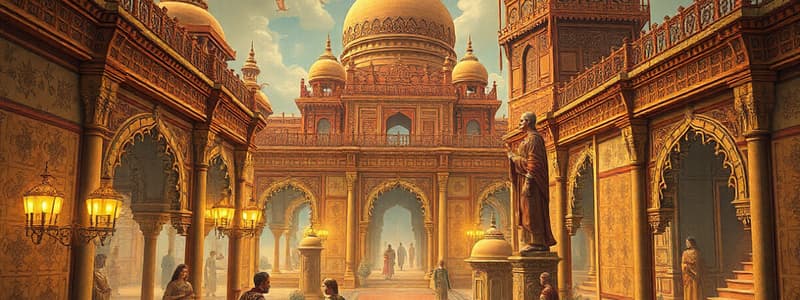Podcast
Questions and Answers
What was a significant consequence of the fall of the Gupta dynasty on India's political landscape?
What was a significant consequence of the fall of the Gupta dynasty on India's political landscape?
Which sources provide information about India's political situation after the Gupta dynasty fell?
Which sources provide information about India's political situation after the Gupta dynasty fell?
During the post-Gupta period, which of the following was commonly observed in regional politics?
During the post-Gupta period, which of the following was commonly observed in regional politics?
How did the fall of the Gupta dynasty influence cultural developments in India?
How did the fall of the Gupta dynasty influence cultural developments in India?
Signup and view all the answers
What characterizes the political entities that emerged after the Gupta dynasty's decline?
What characterizes the political entities that emerged after the Gupta dynasty's decline?
Signup and view all the answers
Which ruler is known for extending the Vardhana dynasty's empire significantly?
Which ruler is known for extending the Vardhana dynasty's empire significantly?
Signup and view all the answers
What was a key feature of the Vardhana dynasty's approach to religion?
What was a key feature of the Vardhana dynasty's approach to religion?
Signup and view all the answers
How did the Vardhana dynasty maintain its political structure?
How did the Vardhana dynasty maintain its political structure?
Signup and view all the answers
What cultural contributions were promoted by the Vardhana dynasty?
What cultural contributions were promoted by the Vardhana dynasty?
Signup and view all the answers
What was a significant historical impact of the Vardhana dynasty?
What was a significant historical impact of the Vardhana dynasty?
Signup and view all the answers
Which contemporary text offers insights into the political and cultural aspects of the Vardhana period?
Which contemporary text offers insights into the political and cultural aspects of the Vardhana period?
Signup and view all the answers
Which ruler was known for establishing a strong base for Harshvardhana's expansion?
Which ruler was known for establishing a strong base for Harshvardhana's expansion?
Signup and view all the answers
What role did cultural exchange play during the Vardhana dynasty?
What role did cultural exchange play during the Vardhana dynasty?
Signup and view all the answers
How did the Vardhana dynasty's military structure contribute to its governance?
How did the Vardhana dynasty's military structure contribute to its governance?
Signup and view all the answers
What happened as a result of the Vardhana dynasty's political unification of northern India?
What happened as a result of the Vardhana dynasty's political unification of northern India?
Signup and view all the answers
Flashcards
Post-Gupta India
Post-Gupta India
The political state of India after the decline of the Gupta Empire.
Sources of study
Sources of study
Archaeological and literary evidence used to understand Post-Gupta India.
Archaeological sources
Archaeological sources
Physical remains like monuments, tools, and artifacts from the period.
Literary sources
Literary sources
Signup and view all the flashcards
Political instability
Political instability
Signup and view all the flashcards
Vardhana Dynasty
Vardhana Dynasty
Signup and view all the flashcards
Harshvardhana
Harshvardhana
Signup and view all the flashcards
Prabhakaravardhana
Prabhakaravardhana
Signup and view all the flashcards
Rajyavardhana
Rajyavardhana
Signup and view all the flashcards
Religious Patronage
Religious Patronage
Signup and view all the flashcards
Centralized Administration
Centralized Administration
Signup and view all the flashcards
Military Force
Military Force
Signup and view all the flashcards
Cultural Promotion
Cultural Promotion
Signup and view all the flashcards
Significance of Unification
Significance of Unification
Signup and view all the flashcards
Study Notes
Political Fragmentation and Regional Kingdoms
- The Gupta Empire's collapse led to a period of political fragmentation and instability in India.
- The absence of a strong central authority allowed various regional kingdoms to emerge and vie for power.
- Archaeological evidence reveals the rise of new dynasties and political entities across different parts of the subcontinent.
- Literary sources like the Harṣacarita and Vikramānkadeva-carita offer insights into the political landscape of this period, highlighting the power struggles and the emergence of powerful regional rulers.
Rise of New Dynasties
- Several dynasties, such as the Vardhanas, the Maukharis, the Chalukyas, and the Rashtrakutas, rose to prominence.
- These regional powers exerted influence over their respective territories, often engaging in conflicts with each other.
- The rise of these dynasties reflected the shifting power balances in the post-Gupta era.
- The varied and diverse political and administrative structures of these regional powers are often highlighted in the rich historical records.
Impact of Foreign Invasions
- The political instability following the Gupta period was further exacerbated by incursions from foreign powers like the Hunas.
- These invasions disrupted existing power structures and contributed to the fragmented political landscape.
- While the Gupta Empire contained the Hunas for some time. The fragmented condition following the collapse of the Empire left regions vulnerable to invasions e.g. the Hephtalites from Central Asia.
Continued Importance of Trade and Economy
- Despite political uncertainties, various aspects of economy and trade within India continued with relative stability or some adjustments.
- The prevalence and sustainability of trade routes and economic activities suggest significant resilience in the Indian society even during this transition period.
- The archaeological discoveries of coins and trade items from this era reveal economic activity across various regions.
Cultural and Religious Developments
- The period after the Gupta empire saw a continuation of various cultural and religious traditions, but with notable nuances and shifts.
- Despite the fragmenting political context, literary and artistic works reflect the continuity of intellectual and artistic pursuits.
- These developments reflect a complex interplay of continuity and change in the cultural sphere after the Gupta empire.
Regional Diversity and Variations
- The fragmentation of the empire led to significant regional variations in terms of political structures, traditions, and social practices.
- Different parts of the country developed unique identities and characteristics during this time.
- Archaeological and literary texts often reflect the diversity of the culture and traditions amongst different regions, kingdoms, and dynasties. This is often emphasized as an integral characteristic of the post-Gupta period.
Limitations of Sources
- Sources for this period, especially in the early phases, may not be as comprehensive or readily available as those for the Gupta epoch.
- Archaeological discoveries may not always offer a complete picture, necessitating interpretations and conclusions based on varying evidence.
- The literary accounts on some times might highlight narratives of some particular groups, while providing limited perspectives on the entire subcontinent's complex situation.
Studying That Suits You
Use AI to generate personalized quizzes and flashcards to suit your learning preferences.
Description
Explore the political fragmentation and the rise of regional kingdoms that followed the collapse of the Gupta Empire. This quiz delves into the emergence of new dynasties like the Vardhanas and Chalukyas and examines literary sources that illuminate the power struggles during this significant historical period.



